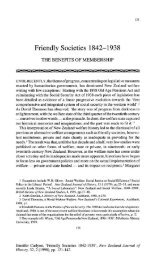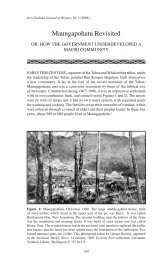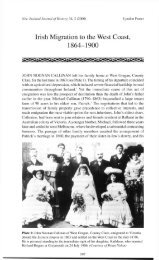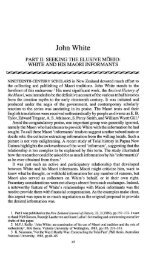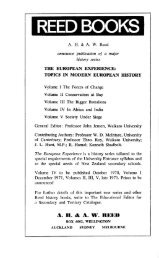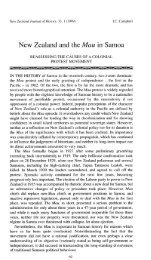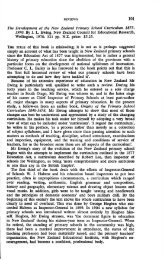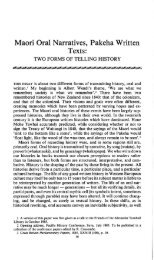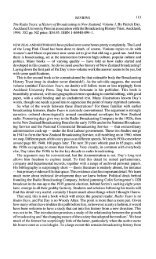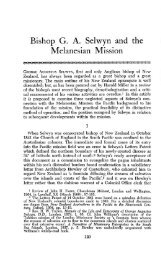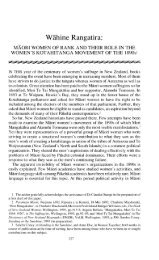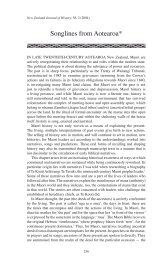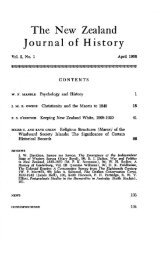Songlines from Aotearoa* - New Zealand Journal of History
Songlines from Aotearoa* - New Zealand Journal of History
Songlines from Aotearoa* - New Zealand Journal of History
Create successful ePaper yourself
Turn your PDF publications into a flip-book with our unique Google optimized e-Paper software.
SONGLINES FROM AOTEAROA 261<br />
the protector <strong>of</strong> tohunga. His second task was to recover his wife and daughter,<br />
whom he had lost by his own foolishness. He went disguised as an old man<br />
but was revealed by the flashing <strong>of</strong> lightening <strong>from</strong> his armpits; a power that is<br />
unique to him. As a result, at daybreak, the rear wall <strong>of</strong> the heavenly meeting<br />
house was broken open by his wife’s kinsfolk, so as to allow the child to go<br />
out into the world <strong>of</strong> light: Tawhaki picked up his daughter and began his first<br />
prayer, which led them outside. 21 Similarly, Tuahu-riri, when searching for his<br />
lost father, entered as a guest into the meeting-house and was there identified<br />
by his ‘kin’. He was then passed out through an opening in the back wall <strong>of</strong><br />
the house, because he, like Tawhaki’s daughter, was still in a state <strong>of</strong> tapu.<br />
However, Tuahu-riri failed to complete the tapu-lifting rites, as he refused to<br />
eat with his newly discovered ‘kin’. His rudeness and anger flowed <strong>from</strong> his<br />
realization that these people had originally intended to kill and eat him while<br />
welcoming him as their guest. The uncertainty <strong>of</strong> the claim that he belonged<br />
to this whanau is hinted at by his failure to complete the tohi (baptismal) rites.<br />
Tuahu-riri (The One-who-stood-angry-at-the-altar) would soon return to bring<br />
death to these people. 22<br />
Rua’s entry into Rongopai in 1906 belongs to this myth structuring. The<br />
narratives <strong>of</strong> the Iharaira (the Israelites, the followers <strong>of</strong> Rua, who are mostly<br />
Tuhoe people <strong>of</strong> the Urewera) state that Rua successfully claimed the house,<br />
the land and his descent as the ‘son’ <strong>of</strong> Te Kooti. Some versions tell how Rua<br />
entered the locked house by bursting through its rear wall. Similar stories are<br />
told <strong>of</strong> Te Kooti himself: at Koriniti, on the Whanganui River, for example,<br />
where the people had previously shown hostility to him, he is said to have burst<br />
violently through the back <strong>of</strong> the house, riding his white horse, and claimed<br />
space for himself and his faith in the centre aisle. 23 At Patutahi and Pakowhai<br />
in Poverty Bay, the local people had been similarly hostile, rejecting Rua’s<br />
claims. From the house Rongopai, it is told, Rua re-emerged through the door<br />
at the front, or variously, through the big front window. In every version <strong>of</strong> this<br />
narrative Rua is described as riding the white horse <strong>of</strong> Te Kooti. In the narrative<br />
sequences <strong>of</strong> Rua, the white horse is named Te Ia (The Crest <strong>of</strong> the Wave), and<br />
photographs exist <strong>of</strong> Rua and Te Ia <strong>from</strong> the period 1905–1906. Many <strong>of</strong> the<br />
stories state that it was Te Ia who gave Rua his entry into Rongopai. Tumeke<br />
Onekawa, who married Rua’s daughter Putiputi, told the narrative this way:<br />
‘He [Rua] was going to meet with Te Kooti at Rongopai. He got to Päköwhai<br />
— they never gave him the key to open the house. But his horse went straight<br />
in — and he had the key. Horse was in, and opened the door for Rua to come<br />
in. That’s how they knew. Because <strong>of</strong> Te Kooti. He said, “I’m going. My time<br />
is up. But my son is coming. You will find that son.” He was to go to Päköwhai.<br />
The horse had the golden key.’ 24 This narrative, which derived <strong>from</strong> Rua,<br />
emphasized the fulfilment <strong>of</strong> the quest.<br />
Two myth-templates most visibly underlie the actions <strong>of</strong> Te Kooti and<br />
Rua: further elements in Tawhaki’s tale, and the story <strong>of</strong> the marakihau (seacreature),<br />
Te Tahi-o-Te-Rangi, who succours his descendants. The Tawhaki<br />
cycle is widespread in Polynesia, and is particularly well known on the East<br />
Coast <strong>of</strong> the North Island, in the Urewera, and in the South Island, where<br />
descendants <strong>of</strong> Kahungunu migrated. Te Tahi-o-Te-Rangi seems to be particular



